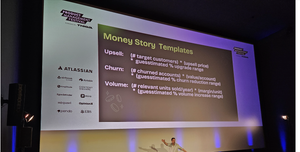I was part of a business-meets-product track at PMF Zurich last week with Simonetta Batteiger, Felicity "Flick" Harding and Sailendra Kumar… we all agreed that product managers and product leaders need directionally clear stories about why our major initiatives matter. Why execs should care. MONEY STORIES. But a series of questions around AI money stories had us all thinking harder.
Several people expressed frustration that their leadership was demanding that product/engineering put huge effort into AI tools and AI projects but without much direction about where to apply this new tech. One PM said that "If we're spending $20M on these tools and tracking my LLM time to make sure I'm spending at least 20% on AI, there must be a solid financial/ business logic that I just don't know about." So how do we tell a money story about investments in tools, training, science experiments, investigations, AI dreams?
This is a huge change; one I've not seen in my 40 years in tech. I've always seen senior leadership skimp on research; be stingy with tools budgets; demand upfront ROIs before signing off on major projects; constantly pull us back to current quarter revenue; pummel product/engineering for more deal-level support.
This moment is the opposite: a full-court press on getting techies to apply immature tools to production systems and live customers. What the f*** is going on?
What I'm Seeing
I talk with a lot of CPOs, CTOs and CEOs… and see this as short-lived anomaly driven by (among other things):
- Existential fear that companies will be driven out of business by more AI-aggressive competitors or one-person AI unicorns
- Intense pressure from investors who see that AI-powered companies are (for a minute) worth much more than traditional companies
- Inescapable press coverage highlighting every shiny AI anecdote, no matter how implausible or inane, alongside AI-polished success stories crafted by tools vendors. Bookended by end-of-humanity-as-we-know-it predictions.
- Job insecurity at every level, where product managers and developers and warehouse workers and lawyers and radiologists see themselves replaced by LLMs
But I am a firm believer in core economics. (As my physicist friends say, "Gravity isn't just a good idea. It's the law.") I see this playing out in money story terms:
- For another two or three quarters, CEOs will push hard on internal AI engagement metrics: tracking employee LLM hours; funding HR-arranged AI training; hiring Chief AI Officers with poorly defined roles. No-questions-asked budgets for AI tools. Roadmaps presented to the Board with vague future AI deliverables and fanciful outcomes.
We'll avoid asking "what will I get for my investment" in favor of FOMO. We'll spend on learning and tooling and early access, not in finished products or market results. - Then the massive cost and diversion from core business issues will become too painful. Leadership will pivot from "figure this stuff out" to "where are those massive ROIs we talked about?" Money stories will rush to the front, framing our best guesses for where we can insert AI to get measurable returns. The stories will be the same, but with AI predicates.
"If we add this new feature, we can upsell customers into our advanced version" ...becomes...
"if we can add this new AI insights feature, we can upsell customers into our AI-enabled version."
But when I guesstimate the required financial returns that CEOs and Board Chairs need soon – to make these bets pay off – I have trouble making it work. Investors expect a 5x-7x return on R&D spending...
Can we see next-year-from-AI savings like 30% fewer support people, or 25% more efficient marketing budgets? 40% more software development, split between shipping more and slashing engineering/product/design? Can AI features drive 35% more product revenue? Talking about order-of-magnitude numbers, rather than vague concepts, makes it more tangible. We may have to posit really big upsides to meet expectations.
(Of course, forecasting major technical improvements has always been perilous, and scheduling the delivery of transformative products is a fool's errand. But here we are.)

Sound Byte
The internal AI investment binge will end soon. As product and engineering leaders, we need to start crafting feasible money stories now. Let's not bring a backlog to a gunfight.

